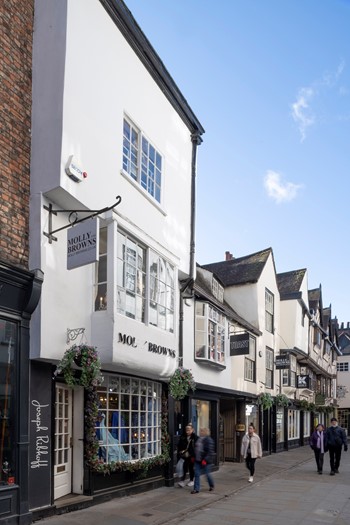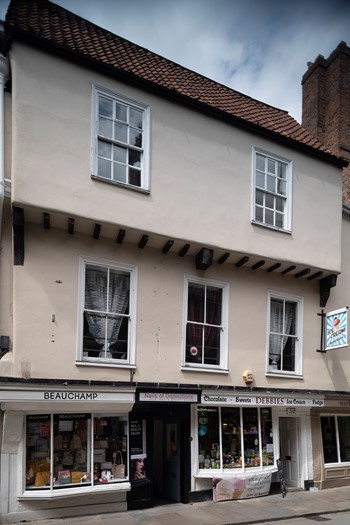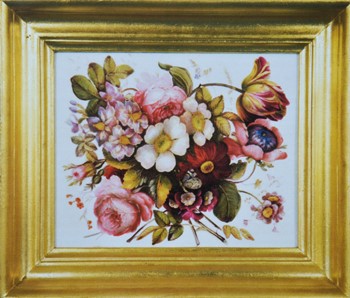12, 14, 16 Stonegate
In the footsteps of Roman legions, Mystery Plays and miracle cures.
Running directly north to south down towards the banks of the river Ouse, this central York street is first mentioned in civic records as early as 1118, but has long been an important and busy thoroughfare.
The name may come from the vast quantity of Tadcaster stone that was unloaded from a quay located behind the present Guildhall for the building of York Minster. The dense cream magnesian limestone was quarried by the Romans for York’s walls – Calcaria is the Roman name for Tadcaster and means ‘place of limestone’. Many years before the building of York Minster, Stonegate was a busy legionary thoroughfare known as the Pretorian Way, which led to the centre of the Roman fortress of Eboracum. The route may well have been paved but these stones being more akin to the large irregular granite sets seen on the roads in Pompei and Herculaneum. Whatever the origins of the name, the street has retained its status as one of the most significant routes through York.
In medieval times Stonegate hosted two of the halting places for the York Guilds’ Mystery Plays, where a parade of some 50 or so wagons formed the performance platforms for biblical pageants to the delight and edification of residents and visitors. The first station was in the vicinity of no. 16, whilst the second was further along at the junction with Petergate.
The street was also a direct route between the Guildhall (and later the Mansion House) to York Minster, the Minster Gates being the only public access to the once enclosed precinct, and, as a result became a street of procession and one geared to high-end, genteel consumption. Several studies record an impressive list of occupations, from goldsmiths, glaziers, hosiers, saddlers, bookshops and printing presses, to apothecaries, tailors, artists and antique dealers. The latter trades occupying at various times, the premises of nos. 12, 14 and 16 Stonegate.
Nos 12 and 14 are jettied at first and second floor level, the stuccoed façade dating from the early 17th century, whilst at the rear are found remnants of a 14th century wing. Evidence of a much earlier construction survives at the front where a part of a substantial corner post is seen to the left of no. 12.
The cornices above both shop units comprise a cased load bearing bressumer beam, the name deriving from the French word somnier meaning ‘bearing a great burden or weight’. At second floor level the jettying is much more substantial and has required, probably at a later date, the addition of brackets at the corners and in the centre. On the inside the most notable feature is a timber newel stair that has, at second floor landing, a short balustrade with 17th-century splat-shaped balusters.
No. 16 is also timber framed but with many later additions. The plastered front is also jettied at first floor level and has a continuation of the same bressumer beam fronting nos. 12 and 14, suggesting common origins.
Access to the rear of all three properties is provided by a side passage within the curtilage of no. 16, where complicated evidence of earlier timber beam construction can be seen. This passage may have proved extremely helpful for no. 18, the adjoining property. It’s here that apothecary Theophilus Garencieres (1610 - 1680) once lived and worked. Born in Paris, Garencieres was the first to translate Nostradamus into English and it seems likely he was also the provider of ‘Medicated Baths’. These were promoted locally as, “the many CURES and GREAT RELIEF which have been received by numbers since the first institution of the BATHS.”
Such a facility would require a greater need for privacy, and this may explain the later 18th century rear extension, which would allow discreet access to the hot and cold baths. It’s also recorded that the celebrated Dr Martin Lister (1639 - 1712 ) was said to have a medical spring at his premises in Stonegate, but whether it was at this same location is uncertain.
As for identifying the various occupants of nos. 12, 14 and 16, the search is sketchy and complicated, not least because street numbering changed in the 19th century. No.12, for example, was formerly nos. 51 and 52 but there is some information we can be sure of from the property’s title deeds. The Nicholson family, father and son, were working as tailors and woollen drapers there until Henry Smith, artist and picture dealer established his Repository of Arts at no.10 and 12 from the 1840s.
As for no.16, family tradition has it that Haigh Hirstwood, a botanical artist and porcelain painter once worked for the Rockingham porcelain factory, supervising the company shop at 17 Coney Street. When the shop closed in 1833 Hirstwood established his own independent shop at no.16 in 1834, calling it the Rockingham China Warehouse, but using undecorated ceramics from the Longton factory. Renowned for his skill in depicting insects and flowers, he was said to have copied upwards of 500 specimens arranged at Wentworth Woodhouse by Lady Milton, daughter-in-law of Earl Fitzwilliam. An illustrated plaque remains, which has descended through the family, and is traditionally attributed to the work of Hirstwood, with help from his son Joseph, who sadly died at the age of 19.
Today, the artistic and high-end shopping experience continues. No 12 Stonegate is currently Beauchamp, run by Daniel and Patsy, the shop offers a range of Italian leather bags and accessories. The salon upstairs, Nails of Distinction, has been run by Leanne for over a decade. Apothecary Born of Botanics can be found at No 14, where you can find a range unique scents, all hand-made and hand-poured in York. No 16 is home to jewellers WERK by TCJ Designs established by Carl Johnson and wife Mandy Morris, both award-winning designers and fellows of the Institute of Goldsmiths.
Discover more about Stonegate
12, 14, 16 Stonegate
York
YO1 8AX
Historic England Grade ll listed building







